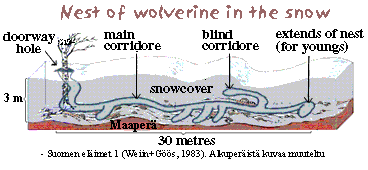
Predators:
Click here:
These mammals in the group of zool. museum:
And these birds in the group of zool. museum:

Predators:
Click here:
These mammals in the group of zool. museum:
And these birds in the group of zool. museum:
Wolverine is the biggest animal in weasel family in Europe, it inhabits taiga and forested tundra. Nowadays it is one of our most endangered species, its strait is a bit abundant only in the borderlines in northern and eastern Finland. We have about hundred wolverines at the moment. Some other maps of large mammals here!
The outer structure of wolverine is sturdy and may give a misleading impression of a clumsy animal, but it is very nimble and tough and also very good in climbing in trees. Especially male may move tens of kilometres in a day. Paws are big if compared to the rest of the body and the pattern of its paws is a bit like the one that bear has (see the snow tracks of large animals!).
Its chin and nape of the neck muscles are very strong as well as its teeth. So it’s able to gnaw on frozen corpses in the winter or carry big parts of corpses into its hiding places. Wolverine eats mainly little mammals and in the winter corpses. It has many food reserves that it finds afterwards with its excellent sense of smell. It is not very good predator, but it uses every opportunity it gets.
The copulation happens in the early summer and the first cubs are born usually by the end of February. The embryonic development is delayed which means that the fertilised ovum doesn’t immediately fasten in to the endometrium.
It has nest in the snow in the boulder soil of fells or in the forest for example under fallen tree. There isn’t any siding in its nest but the thick snow cover shelters the cubs in the winter.

 Rough-legged buzzard (Buteo lagopus) is closely related to buzzard. Rough-legged buzzard nests only in northern Finland, first of all in Fjeld and Forest Lappland. Its life is strongly dependent on the population dynamics of small mammals. When moles and lemmings are abundant, usually after every 3-5 years, are rough-legged buzzards doing well and reproducing effectively. And when it’s poor small mammal year migrates rough-legged buzzard to better food places. It is also a seasonal migrator, so it can be seen in southern Finland, too.
Rough-legged buzzard (Buteo lagopus) is closely related to buzzard. Rough-legged buzzard nests only in northern Finland, first of all in Fjeld and Forest Lappland. Its life is strongly dependent on the population dynamics of small mammals. When moles and lemmings are abundant, usually after every 3-5 years, are rough-legged buzzards doing well and reproducing effectively. And when it’s poor small mammal year migrates rough-legged buzzard to better food places. It is also a seasonal migrator, so it can be seen in southern Finland, too.
The section "Predators" ends here!